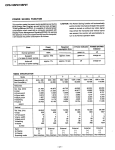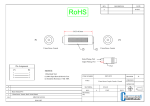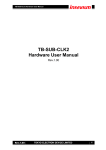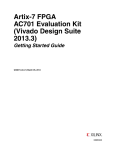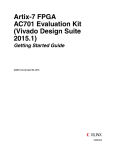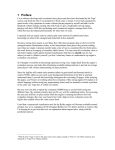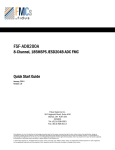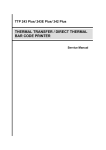Download TB-7K-325T-IMG Hardware User Manual
Transcript
TB-7K-325T-IMG Hardware User Manual TB-7K-325T-IMG Hardware User Manual Rev.1.09 Rev.1.09 1 TB-7K-325T-IMG Hardware User Manual Revision History Version Date Description Publisher Rev.1.00 2012/05/14 Initial Release Yoshioka Rev.1.01 2012/05/18 Add FAN/Heat sink information Yoshioka Rev.1.02 2012/05/29 Add related document information Yoshioka Rev.1.03 2012/06/06 Modified Figure7-11 Odajima Rev.1.04 2012/12/27 Modified Figure7-15 Table7-6 Yanagisawa Rev.1.05 2013/03/25 Modified Figure7-15 HA13_N Yoshioka Rev.1.06 2013/05/16 Modified Table7-6 HA13_P Amano Rev.1.07 2013/06/05 Modified Table7-6 Bank No.of LA08,LA12 Amano Rev.1.08 2014/02/18 Modified Figure7-11, 7.3.2 Amano Rev.1.09 2014/04/15 Modified Figure7-13、Add EC Declaration of Conformity Amano Rev.1.09 2 TB-7K-325T-IMG Hardware User Manual Table of Contents 1. 2. 3. 4. 5. 6. 7. Related Documents and Accessories ....................................................................................... 10 Overview .................................................................................................................................... 10 Feature .......................................................................................................................................11 Block Diagram ........................................................................................................................... 12 External View of the Board ........................................................................................................ 13 Board Specifications .................................................................................................................. 14 Description of Components ....................................................................................................... 15 7.1. 7.1.1. Power Input connectors ................................................................................................... 16 7.1.2. Power supply circuit LEDs ............................................................................................... 16 7.1.3. FPGA Bank Voltage Selection ......................................................................................... 17 7.1.4. Power Supply for XADC .................................................................................................. 18 7.1.5. PM Bus interface (CN19) ................................................................................................. 18 7.2. Clock Structure ........................................................................................................................ 19 7.3. RocketIO Reference Clock ...................................................................................................... 21 7.3.1. FB_CLEANUP_CLP/N Signals ........................................................................................ 21 7.3.2. Clock Generator (ISC810001DK-21LF) .......................................................................... 22 7.3.3. RocketIO Reference Clock Selector ................................................................................ 23 7.4. 8. Power Supply structure ........................................................................................................... 15 FMC connectors ...................................................................................................................... 24 7.4.1. FMC HPC1(CN3) ............................................................................................................. 25 7.4.2. FMC HPC2(CN4) ............................................................................................................. 33 7.4.3. FMC LPC1(CN5) ............................................................................................................. 40 7.4.4. FMC LPC2(CN6) ............................................................................................................. 44 7.5. DDR3 SDRAM ......................................................................................................................... 48 7.6. UART ....................................................................................................................................... 50 7.7. LED .......................................................................................................................................... 51 7.8. DIP SW .................................................................................................................................... 52 7.9. Push SW .................................................................................................................................. 53 7.10. Pin Header ........................................................................................................................... 54 7.11. Battery ..................................................................................................................................... 55 7.12. Quad SPI Flash ................................................................................................................... 55 7.13. FPGA JTAG IF ..................................................................................................................... 56 Creating a Configuration File and Operation ............................................................................ 57 8.1. Process properties of generate programing file ...................................................................... 57 8.2. Configuration Rate ................................................................................................................... 58 8.3. Setting for unused IOB pins..................................................................................................... 58 8.4. Generate Target PROM File(MCF File) ................................................................................... 59 8.5. Downloading the configuration file to Flash memory .............................................................. 64 8.6. Default Settings ....................................................................................................................... 69 Rev.1.09 3 TB-7K-325T-IMG Hardware User Manual List of Figures Figure 4-1 Block Diagram ................................................................................................................ 12 Figure 5-1 Top View of Board ........................................................................................................... 13 Figure 5-2 Bottom View of Board ..................................................................................................... 13 Figure 6-1 Board Dimensions (inclusive of wastable substrate) ...................................................... 14 Figure 7-1 Power Supply Circuit Structure ....................................................................................... 15 Figure 7-2 Power Input Circuit ......................................................................................................... 16 Figure 7-3 Power LED ...................................................................................................................... 16 Figure 7-4 Bank Assign Overview .................................................................................................... 17 Figure 7-5 IO Bank Voltage Jumpers ............................................................................................... 17 Figure 7-6 XADC Power Select Circuit ............................................................................................ 18 Figure 7-7 XADC Jumper setting ..................................................................................................... 18 Figure 7-8 Clock Structure ............................................................................................................... 19 Figure 7-9 On Board Clock Sources and Connectors ...................................................................... 19 Figure 7-10 RocketIO Reference Clock Structure ............................................................................ 21 Figure 7-11 FB_CLEANUP_CLKP/N Circuit Block Diagram ............................................................ 21 Figure 7-12 RocketIO Reference Clock Selector Block Diagram .................................................... 23 Figure 7-13 RocketIO Reference Clock Setting Table ..................................................................... 23 Figure 7-14 High Pin Count .............................................................................................................. 24 Figure 7-15 Low Pin Count .............................................................................................................. 24 Figure 7-16 HPC1 SDC/SCL, GA1/0, TDI/TDO connection ............................................................ 31 Figure 7-17 HPC1 PG_C2M connection .......................................................................................... 31 Figure 7-18 HPC1 VADJ Connection ............................................................................................... 32 Figure 7-19 HPC2 SDC/SCL, GA1/0, TDI/TDO connection ............................................................ 38 Figure 7-20 HPC2 PG_C2M connection .......................................................................................... 38 Figure 7-21 HPC2 VADJ Connection ............................................................................................... 39 Figure 7-22 LPC1 SDC/SCL, GA1/0, TDI/TDO connection ............................................................. 42 Figure 7-23 LPC1 PG_C2M connection........................................................................................... 42 Figure 7-24 LPC1 VADJ Connection ................................................................................................ 43 Figure 7-25 LPC2 SDC/SCL, GA1/0, TDI/TDO connection ............................................................. 46 Figure 7-26 LPC2 PG_C2M connection........................................................................................... 46 Figure 7-27 LPC2 VADJ Connection ................................................................................................ 47 Figure 7-28 DDR3 SDRAM connection ............................................................................................ 48 Figure 7-29 UART Bloc Diagram...................................................................................................... 50 Figure 7-30 UART Connector........................................................................................................... 50 Figure 7-31 LED Circuit .................................................................................................................... 51 Figure 7-32 LED on board view ....................................................................................................... 51 Figure 7-33 DIP SW Circuit .............................................................................................................. 52 Figure 7-34 DIP SW on board view .................................................................................................. 52 Figure 7-35 Push SW Circuit ............................................................................................................ 53 Figure 7-36 Push SW on board view ............................................................................................... 53 Figure 7-37 XADC Interface Circuit .................................................................................................. 54 Figure 7-38 XADC Pin header on board view .................................................................................. 54 Figure 7-39 XADC Pin header Pin Assign Table .............................................................................. 54 Figure 7-40 Battery circuit and Pad on bottom ................................................................................ 55 Figure 7-41 QSPI Flash memory circuit ........................................................................................... 55 Rev.1.09 4 TB-7K-325T-IMG Hardware User Manual Figure 8-1 Open the process properties window ............................................................................. 57 Figure 8-2 Process Properties window ............................................................................................ 57 Figure 8-3 Configuration Rate .......................................................................................................... 58 Figure 8-4 Unused IOB pins ............................................................................................................. 58 Figure 8-5 Generate Target PROM/ACE File on ISE ....................................................................... 59 Figure 8-6 Warning window .............................................................................................................. 59 Figure 8-7 iMPCAT - window 1 - ...................................................................................................... 60 Figure 8-8 iMPACT - windows 2 -..................................................................................................... 60 Figure 8-9 iMPACT - window 3 - ...................................................................................................... 61 Figure 8-10 iMPACT - window 4 - .................................................................................................... 61 Figure 8-11 iMPACT - window 5 - ..................................................................................................... 62 Figure 8-12 iMPACT - window 6 - .................................................................................................... 62 Figure 8-13 iMPACT - window 7 - .................................................................................................... 62 Figure 8-14 iMPACT - window 8 - .................................................................................................... 62 Figure 8-15 iMPACT - window 9 - .................................................................................................... 63 Figure 8-16 iMPACT - window 10 - .................................................................................................. 63 Figure 8-17 JTAG connector (CN1) ................................................................................................. 64 Figure 8-18 Download operation 1 ................................................................................................... 64 Figure 8-19 Download operation 2 ................................................................................................... 65 Figure 8-20 Download operation 3 ................................................................................................... 65 Figure 8-21 Download operation 4 ................................................................................................... 66 Figure 8-22 Download operation 5 ................................................................................................... 66 Figure 8-23 Download operation 6 ................................................................................................... 67 Figure 8-24 Download operation 7 ................................................................................................... 67 Figure 8-25 Download operation 8 ................................................................................................... 68 Figure 8-26 Reconfiguration Switch ................................................................................................. 68 Figure 8-27 Configuration Status LED ............................................................................................. 68 Figure 8-28 Jumper and DIP Switches location ............................................................................... 69 Rev.1.09 5 TB-7K-325T-IMG Hardware User Manual List of Tables Table 7-1 Power LED ....................................................................................................................... 16 Table 7-2 Bank Voltage Settings ...................................................................................................... 17 Table 7-3 Setting of XACD Power .................................................................................................... 18 Table 7-4 Clock Source Table .......................................................................................................... 20 Table 7-5 Clock Generator(ISC810001DK-21F) setting................................................................... 22 Table 7-6 HPC1(CN3) Pin Assign Table ........................................................................................... 26 Table 7-7 HPC1 PG_C2M, PG_M2C, PRSNT_M2C_L Level settings ............................................ 31 Table 7-8 HPC2(CN4) Pin Assign Table ........................................................................................... 33 Table 7-9 HPC2 PG_C2M, PG_M2C, PRSNT_M2C_L Level settings ............................................ 38 Table 7-10 LPC1(CN5) Pin Assign Table ......................................................................................... 40 Table 7-11 LPC1 PG_C2M, PG_M2C, PRSNT_M2C_L Level settings ........................................... 42 Table 7-12 LPC2(CN6) Pin Assign Table ......................................................................................... 44 Table 7-13 LPC2 PG_C2M, PG_M2C, PRSNT_M2C_L Level settings ........................................... 46 Table 7-14 DDR3 SDRAM on board view ........................................................................................ 48 Table 7-15 DDR3 -1 Pin Assign ........................................................................................................ 49 Table 7-16 UART IF Pin Assign ........................................................................................................ 50 Table 7-17 User LED Pin Assign ...................................................................................................... 51 Table 7-18 DIP SW Pin Assign ......................................................................................................... 52 Table 7-19 Push SW Pin Assign ....................................................................................................... 53 Table 7-20 QSPI Flash memory connection..................................................................................... 55 Table 7-21 FPGA JTAG IF Pin Assign .............................................................................................. 56 Table 8-1 Default Settings ................................................................................................................ 69 Rev.1.09 6 TB-7K-325T-IMG Hardware User Manual Introduction Thank you for purchasing the TB-7K-325T-IMG board. Before using the product, be sure to carefully read this user manual and fully understand how to correctly use the product. First read through this manual, then always keep it handy. SAFETY PRECAUTIONS Be sure to observe these precautions Observe the precautions listed below to prevent injuries to you or other personnel or damage to property. Before using the product, read these safety precautions carefully to assure correct use. These precautions contain serious safety instructions that must be observed. After reading through this manual, be sure to always keep it handy. The following conventions are used to indicate the possibility of injury/damage and classify precautions if the product is handled incorrectly. Danger Indicates the high possibility of serious injury or death if the product is handled incorrectly. Indicates the possibility of serious injury or death if the product is handled Warning incorrectly. Indicates the possibility of injury or physical damage in connection with houses or Caution household goods if the product is handled incorrectly. The following graphical symbols are used to indicate and classify precautions in this manual. (Examples) Turn off the power switch. Do not disassemble the product. ! Rev.1.09 Do not attempt this. 7 TB-7K-325T-IMG Hardware User Manual Warning In the event of a failure, disconnect the power supply. If the product is used as is, a fire or electric shock may occur. Disconnect the power supply immediately and contact our sales personnel for repair. If an unpleasant smell or smoking occurs, disconnect the power supply. If the product is used as is, a fire or electric shock may occur. immediately. Disconnect the power supply After verifying that no smoking is observed, contact our sales personnel for repair. Do not disassemble, repair or modify the product. Otherwise, a fire or electric shock may occur due to a short circuit or heat generation. For inspection, modification or repair, contact our sales personnel. ! Do not touch a cooling fan. As a cooling fan rotates in high speed, do not put your hand close to it. cause injury to persons. ! Otherwise, it may Never touch a rotating cooling fan. Do not place the product on unstable locations. Otherwise, it may drop or fall, resulting in injury to persons or failure. ! If the product is dropped or damaged, do not use it as is. ! Do not touch the product with a metallic object. ! Do not place the product in dusty or humid locations or where water may Otherwise, a fire or electric shock may occur. Otherwise, a fire or electric shock may occur. splash. Otherwise, a fire or electric shock may occur. ! ! Do not get the product wet or touch it with a wet hand. Otherwise, the product may break down or it may cause a fire, smoking or electric shock. Do not touch a connector on the product (gold-plated portion). Otherwise, the surface of a connector may be contaminated with sweat or skin oil, resulting in contact failure of a connector or it may cause a malfunction, fire or electric shock due to static electricity. Rev.1.09 8 TB-7K-325T-IMG Hardware User Manual Caution Do not use or place the product in the following locations. ! Humid and dusty locations Airless locations such as closet or bookshelf Locations which receive oily smoke or steam Locations exposed to direct sunlight Locations close to heating equipment Closed inside of a car where the temperature becomes high Staticky locations Locations close to water or chemicals Otherwise, a fire, electric shock, accident or deformation may occur due to a short circuit or heat generation. ! Do not place heavy things on the product. Otherwise, the product may be damaged. ■ Disclaimer This product is an evaluation board for Xilinx Kintex-7 FPGA. Tokyo Electron Device Limited assumes no responsibility for any damages resulting from the use of this product for purposes other than those stated. Even if the product is used properly, Tokyo Electron Device Limited assumes no responsibility for any damages caused by: (1) Earthquake, thunder, natural disaster or fire resulting from the use beyond our responsibility, acts by a third party or other accidents, the customer’s willful or accidental misuse or use under other abnormal conditions. (2) Secondary impact arising from use of this product or its unusable state (business interruption or others) (3) Use of this product against the instructions given in this manual. (4) Malfunctions due to connection to other devices. Tokyo Electron Device Limited assumes no responsibility or liability for: (1) Erasure or corruption of data arising from use of this product. (2) Any consequences or other abnormalities arising from use of this product, or (3) Damage of this product not due to our responsibility or failure due to modification This product has been developed by assuming its use for research, testing or evaluation. It is not authorized for use in any system or application that requires high reliability. Repair of this product is carried out by replacing it on a chargeable basis, not repairing the faulty devices. However, non-chargeable replacement is offered for initial failure if such notification is received within two weeks after delivery of the product. The specification of this product is subject to change without prior notice. The product is subject to discontinuation without prior notice. Rev.1.09 9 TB-7K-325T-IMG Hardware User Manual 1. Related Documents and Accessories Related documents: All documents relating to this board can be downloaded from our website. ( http://ppg.teldevice.co.jp/eng/index.htm) Xilinx FPGA document: http://www.xilinx.com/support/documentation/index.htm DS180: 7 Series FPGAs Overview UG586: 7 Series FPGAs Memory Interface Solutions User Guide UG473: 7 Series FPGAs Memory Resources User Guide UG470: 7 Series FPGAs Configuration User Guide UG475: 7 Series FPGAs Packaging and Pinout User Guide UG476: 7 Series FPGAs GTX Transceivers User Guide UG477: 7 Series FPGAs Integrated Block for PCI Express User Guide UG480: 7 Series FPGAs XADC User Guide On board accessories: - Board Foot Rubber foot: 9, - Screw M3 x 6: 18, Spacer M3 x 10: 9 74.25MHz Oscillator (MXO-50B): Mounted on X2(Socket) Accessories: - MMCX Cable Set MMCX - SMA Cable(Samtec: RF174-03SP1-01SP1-0400): 2 - MMCX - MMCX Cable(Samtec: RF174-03SP1-03SP1-0400): 2 FMC Spacer Set Spacer M2.6 x 10: 6 - Screw with washer: 12 Jumper Socket(Samtec: 2SN-BK-G): 14 - FAN/Heat sink(ALPHA: FS40-15M42): 1 - AC adapter(AIKOH ELECTRONICS CORP: TW-1250P or equivalent): 1 2. Overview TB-7K-325T-IMG is evaluation platform of Xilinx Kintex-7 FPGA. Mainly, it can used for Video Interface and Video Processing applications. Speed grade -2 FPGA is mounted on this board. Rev.1.09 10 TB-7K-325T-IMG Hardware User Manual 3. Feature - Xilinx Kintex-7 FPGA: XC7K325T-2FFG900CES (General ES Device) - DDR3 Memory: EDJ2116DEBG-**-* 2Gbit x 4 or equivalent device - Configuration PROM: Quad SPI Flash 128Mbit x 1 - FMC option connecters x 4 *Please refer detail pin assign HPC(High Pin Count) x 2 - LPC(Low Pin Count) x 2 On Board Clock 74.25MHz OSC(Socket) 135MHz OSC 200MHz OSC - PLL Interface MMCX for external clocks. UART(RS-232C D-sub 9pin) XADC interface to Pin Header Push Switches, DIP Switches and LEDs JTAG Rev.1.09 11 TB-7K-325T-IMG Hardware User Manual 4. Block Diagram Following figure shows block diagram of TB-7K-325T-IMG TB-7K-325T-IMG FMC_LPC1 (low-pin count) [SAMTEC] ASP-134603-01 ADR,CLK,CMD CLK:2 pair/IO:34 pair Data[15:0],DQS,DM FMC_LPC2 (low-pin count) [SAMTEC] ASP-134603-01 FMC_HPC2 (high-pin count) [SAMTEC] ASP-134486-01 CLK:2 pair/IO:34 pair Data[15:0],DQS,DM GTX:8 pair/GTX_CLK:2 pair Data[15:0],DQS,DM LA:CLK:2 pair/IO:34 pair Data[15:0],DQS,DM DDR3 SDRAM(2Gbit) [ELPIDA] EDJ2116DEBG-xx-x DDR3 SDRAM(2Gbit) [ELPIDA] EDJ2116DEBG-xx-x DDR3 SDRAM(2Gbit) [ELPIDA] EDJ2116DEBG-xx-x DDR3 SDRAM(2Gbit) [ELPIDA] EDJ2116DEBG-xx-x GTX:8 pair/GTX_CLK:2 pair FMC_HPC1 (high-pin count) [SAMTEC] ASP-134486-01 pair LA:CLK:2 pair/IO:34 pair HA_HB:CLK:2 pair/HA:12 pair, HB:12 pair pair GTX_CLK:1 pair LVDS 4x4 CROSSPOINT SWITCH [TI] SN65LVDS250D BT GTX_CLK:1 pair OSC 135MHz [TamaDevice] CL20VBC 135.000MHz pair pair MMCX Connector [SAMTEC] MMCX-J-P-H-ST-TH1 OSC 74.25MHz [MITADENPA] MXO-50B 74.25MHz Level Shifter [TI] TXS0108EPWR FPGA [Xilinx] Kintex-7 Level Shifter [TI] TXB0102DC Dip Switch(4 poles) [Omron] A6H-4101 Dip Switch(8 poles) [Omron] A6H-8101 LVDS Buffer [TI] CDCLVD 2102RGT RS-232C Line Driver [TI] TRS3221ECPWR pair MMCX Connector [SAMTEC] MMCX-J-P-H-ST-TH1 D-sub Connector [Omron] XM2C-0942-112L MMCX Connector [SAMTEC] MMCX-J-P-H-ST-TH1 MMCX Connector [SAMTEC] MMCX-J-P-H-ST-TH1 GTX REFCLK pair pair Push Switch [Omron] B3SN-3012 MMCX Connector [SAMTEC] MMCX-J-P-H-ST-TH1 QSPI FLASH [Micron] N25Q128A13BSF40G JTAG Connector [molex] 87832-1420 XC7K325T -FFG900 CLK CLEANER [IDT] ICS810001DK-21LF IC Socket [Omron] XR2A-0811-N LVDS BUFFER [TI] CDCLVD2102RGT 4pair Dip Switch(8 poles) [Omron] A6H-8101 XTAL 26.973MHz [TamaDevice] HC-49/T XTAL 27MHz [TamaDevice] HC-49/T OSC 200MHz [TamaDevice] CL20VBC MMCX Connector MMCX Connector [SAMTEC] [SAMTEC] MMCX-J-P-H-ST-TH1 MMCX-J-P-H-ST-TH1 MMCX Connector MMCX Connector [SAMTEC] [SAMTEC] MMCX-J-P-H-ST-TH1 MMCX-J-P-H-ST-TH1 PMBUS PinHeader (10 pin) [SAMTEC] TSM-105-01-L-DV Clock Buffer [TI] CDCLVC1102PW XADC PinHeader (14 pin) [SAMTEC] TSM-107-01-L-DV Push Switch x4 [Omron] B3SN-3012 pair MMCX Connector [SAMTEC] MMCX-J-P-H-ST-TH1 Dip Switch(8 poles) [Omron] A6H-8101 LED x6 [STANLEY] AA1111C-TR Figure 4-1 Block Diagram Rev.1.09 12 TB-7K-325T-IMG Hardware User Manual 5. External View of the Board FMC Connector MMCX LVDS (Low Pin) Output FMC Connector (Low Pin) JTAG QSPI Flash Memory D-sub Connector MMCX LVDS Input Clock Cleaner Reset SW Clock Cleaner MMCX Single In/Out MMCX MGT Input FPGA DDR3 SDRAM LVDS 4x4 CROSSPOINT SWITCH ReConfig SW FMC Connector (High Pin) Power LED OSC 150M Option OSC (74.25M) Power SW MMCX MGT Input FMC Connector (High Pin) XADC PinHeader LED Dip SW Push SW PMBUS PinHeader Figure 5-1 Top View of Board Figure 5-2 Bottom View of Board Rev.1.09 13 TB-7K-325T-IMG Hardware User Manual 6. Board Specifications Figure 6-1 shows the board specifications. External Dimensions: 240.0 mm (W) x 175.0 mm (H) Number of Layers: 12 layers Board Thickness: 1.6 mm Material: FR-4 Figure 6-1 Board Dimensions (inclusive of wastable substrate) Rev.1.09 Unit: mm 14 TB-7K-325T-IMG Hardware User Manual 7. Description of Components This section described detail of each component and function. 7.1. Power Supply structure Figure 7-1 shows a power supply circuit structure. TB-7K-325T-IMG has two power connecters for input 12V power. One is ATX type connector other one is DC JACK type connector. All of required voltages are made by on-board power circuit. ATX Power Connector [TI] TPS56121DQPT 1.0V 15A FPGA (CORE) [TI] TPS84620RUQR 1.8V 6A FPGA (VCCAUX) [TI] TPS54325PWP 2.5V 3A FPGA (IO) [TI] TPS54325PWP 3.3V 3A FPGA (IO) Power Switch DC JACK 3.3V [TI] TLV70018DCKT 1.8V FPGA 200mA (MGTAVCCAUX) [TI] REF3012 1.25V FPGA (VREFP) [TI] TLV70218DBV 1.8V FPGA (VCCADC) [TI] TPS51200DRCT 0.75V 200mA FPGA (VTT) [TI] TPS54527DDAR 1.5V 5A FPGA (DDR3) [TI] TPS54227DDAR 2.0V 2A FPGA (VCCAUXIO) [TI] TPS54227DDAR 1.5V 2A QSPI Flash memory [TI] TLV74401KTWT 1.2V 3A [TI] TPS54620RGYR 1.0V 6A FPGA (MGTAVCC) [TI] TPS54527DDAR 2.5V 5A Option Board (FMC) [TI] TPS54527DDAR 3.3V 5A Option Board (FMC) [TI] TPS73801DCQR 3.3V FPGA (MGTAVTT) UCD9090 (Power Supply Sequencer/Monitor) Figure 7-1 Power Supply Circuit Structure Rev.1.09 15 TB-7K-325T-IMG Hardware User Manual 7.1.1. Power Input connectors TB-7K-325T-IMG has two power connectors, DC Jack or ATX power connector. Figure 7-2 Power Input Circuit 7.1.2. Power supply circuit LEDs All power circuits have an indicating LEDs. If LED is OFF or flashing, Power circuit has a problem. Table 7-1 Power LED Voltage LED # Power Supply for VCCINT+1.0V LED7 FPGA VCCINT VCCAUXIO+2.0V LED8 FPGA VCCAUX_IO MGT_PW+1.5V LED9 MGT AVTT UCD9090_+3.3V LED10 UCD9090RGZT VCC+1.5V LED11 FPGA VCCIO VCC+2.5V LED12 FPGA VCCIO MGTAVCCAUX+1.8V LED13 MGTAVCCAUX FMC+2.5V LED14 FMC 2.5V VCCAUX+1.8V LED15 FPGA VCCAUX VCC_CF LED16 QSPI Flash Memory MGTAVTT+1.2V LED17 MGTAVTT FMC+3.3V LED18 FMC 3.3V VTT+0.75V LED19 FPGA VREF(DDR3) VCC+3.3V LED20 FPGA VCCIO MGTAVCC+1.0V LED21 MGTAVCC +12V LED22 12V Master Power VREFP+1.25V LED33 FPGA VREFP VCCADC+1.8V LED34 FPGA VCCADC Figure 7-3 Power LED Rev.1.09 16 TB-7K-325T-IMG Hardware User Manual 7.1.3. FPGA Bank Voltage Selection Various peripheral devices are connected to FPGA as shown in following figure. The FMC connectors allow the developers to select an appropriate FPGA Bank voltage(VCCIO) by setting the on-board jumpers(JP24, JP28) to meet the voltage requirements for the connected interfaces. 【HR18】 HPC1 【HR17】 HPC1 【HR16】 HPC1・HPC2 GTX Quad 4ch/Bank 【HR15】 HPC1・HPC2 【HR14】 LPC1・QSPI 【HP32】 DQ,DQS,DM x2 【HP34】 DQ,DQS,DM x2 【HP33】 ADR,CMD x4 RS-232C IF LED,PSW,DSW 【HR13】 LPC1・LPC2 【HR12】 LPC1・LPC2 Figure 7-4 Bank Assign Overview Table 7-2 Bank Voltage Settings Bank # Connected Peripherals FMC_LPC1(CN5) HR12/13/14 FMC_LPC2(CN6) QSPI HR15/16/17/18 HP32/33/34 Voltage Selectable 3.3V, 2.5V FMC_HPC1(CN3) Selectable FMC_HPC2(CN4) 3.3V, 2.5V DDR3,DSW,LED,PSW,UART 1.5V Setting JP # JP28 JP24 - 2.5V 1-2 (Default) 1-2 (Default) - 3.3V 2-3 2-3 - Figure 7-5 IO Bank Voltage Jumpers Rev.1.09 17 TB-7K-325T-IMG Hardware User Manual 7.1.4. Power Supply for XADC TB-7K-325T-IMG has two voltages for XADC. About XADC, please refer to Kintex-7 datasheet. VCCADC is power supply of XADC Analog circuit. VREFP is reference voltage for conversion of deferential signal . Table 7-3 Setting of XACD Power XADC Power JP # and setting VCCADC JP39 VREFP JP40 Supplied power Short 1-2 VCCAUX+1.8V Short 2-3 VCCADC+1.8V Short 1-2 XADC_AGND Short 2-3 VREFP+1.25V Figure 7-6 XADC Power Select Circuit Figure 7-7 XADC Jumper setting 7.1.5. PM Bus interface (CN19) PM bus interface is TI digital power device control bus interface. This board uses TI UCD9090 for power supply controller and it is programed all settings before shipping. For more details, please refer to UCD9090 and FPGA Power sequence. Rev.1.09 18 TB-7K-325T-IMG Hardware User Manual 7.2. Clock Structure Figure 7-1 shows clock structure. IC16 CN3 X4 FMC HPC1 IC29 LVDS 135MHz OSC LVDS LVDS LVDS LVDS FMC HPC2 DIPSW SW2,3 IC28 CN4 FMC HPC2 IC27 FB_CLEANUP_CLKP/N CLK1 LVDS CN14 MMCX_LVDS_OUT_P MMCX_LVDS_OUT_N CLK0 CN15 DIPSW CDCLVD2102RGT SW4 CLK Cleaner ICS810001-21 Ctrl MGT116 L8/L7 MGTREFCLK0P/N_116 N8/N7 MGTREFCLK1P/N_116 CN4 CN16 MMCX_Single_IN MGT115 R8/R7 MGTREFCLK0P/N_115 U8/U7 MGTREFCLK1P/N_115 CN9 MMCX_MGT1_P MMCX_MGT1_N CN10 LVDS CN3 FMC HPC1 LVDS LVDS LVDS MGT117 G8/G7 MGTREFCLK0P/N_117 J8/J7 MGTREFCLK1P/N_117 LVCMOS33 SEL CN11 MMCX_MGT2_P MMCX_MGT2_N CN12 LVDS LVDS MGT118 C8/C7 MGTREFCLK0P/N_118 E8/E7 MGTREFCLK1P/N_118 SN65LVDS250 IC26 IC42 CN13 MMCX_Single_OUT Level Translator CDCLVC1102PW X1 200MHz OSC SN74LVC1T45DCK LVDS X2 IC24 74.25MHz OSC CN7 LVCMOS33 P N P N AE10:HP33 AF10:HP33 F12:HR18 E13:HR18 CDCLVD2102 MMCX_P MMCX_N CN3 LVDS U20:HR14 LVDS P N M28:HR15 L28:HR15 CN8 P N FMC HPC1 P N P N P N D12:HR18 D13:HR18 G13:HR18 F13:HR18 E19:HR17 D19:HR17 H14:HR18 G14:HR18 CN4 FMC HPC2 P N P N D27:HR16 C27:HR16 C25:HR16 B25:HR16 CN5 FMC LPC1 P N P N T26:HR14 T27:HR14 AE23:HR12 AF23:HR12 CN6 FMC LPC2 P N P N AG29:HR13 AH29:HR13 AB27:HR13 AC27:HR13 FPGA Figure 7-8 Clock Structure Figure 7-9 On Board Clock Sources and Connectors Rev.1.09 19 TB-7K-325T-IMG Hardware User Manual Table 7-4 Clock Source Table Connection Signal Name I/F FPGA PIN X1(200MHz) CLK200M_P/N LVDS AE10/AF10 X2(74.25MHz) 74.25MHz_P/N LVDS F12/E13 CN7/8 MMCX_P/N LVDS M28/L28 Note For DDR3 (System, iodelayctrl) Via Single-end to Differential buffer External Clock In IC27 (FB_CLEANUP_CLKP/N), CN3 HPC_CLK_M115_P/N (HPC1_GBTCLK1_M2C_P/N), HPC_CLK_M116_P/N CN4 HPC_CLK_M117_P/N (HPC2_GBTCLK1_M2C_P/N) HPC_CLK_M118_P/N U8/U7 LVDS N8/N7 J8/J7 E8/E7 or Reference clock X4(135MHz_P/N) of RocketIO CN3(FMC_HPC1) HPC1_GBTCLK0_M2C_P/N LVDS R8/R7 CN4(FMC_HPC2) HPC2_GBTCLK0_M2C_P/N LVDS G8/G7 MMCX_MGT1_P/N LVDS L8/L7 MMCX_MGT2_P/N LVDS C8/C7 CN9/10 (MMCX, LVDS input) CN11/12 (MMCX, LVDS input) CN3(FMC_HPC1) HPC1_CLK0_M2C_P/N CN3(FMC_HPC1) HPC1_CLK1_M2C_P/N CN3(FMC_HPC1) HPC1_CLK2_M2C_P/N CN3(FMC_HPC1) HPC1_CLK3_M2C_P/N CN4(FMC_HPC2) HPC2_CLK0_M2C_P/N CN4(FMC_HPC2) HPC2_CLK1_M2C_P/N CN5(FMC_LPC1) LPC1_CLK0_M2C_P/N CN5(FMC_LPC1) LPC1_CLK1_M2C_P/N CN6(FMC_LPC2) LPC2_CLK0_M2C_P/N CN6(FMC_LPC2) LPC2_CLK1_M2C_P/N Rev.1.09 LVDS CMOS LVDS CMOS LVDS CMOS LVDS CMOS LVDS CMOS LVDS CMOS LVDS CMOS LVDS CMOS LVDS CMOS LVDS CMOS D12/D13 HPC_LA I/F G13/F13 HPC_LA I/F E19/D19 HPC_HA_HB I/F H14/G14 HPC_HA_HB I/F D27/C27 HPC_LA I/F C25/B25 HPC_LA I/F T26/T27 LPC1 I/F AE23/AF23 LPC1 I/F AG29/AH29 LPC2 I/F AB27/AC27 LPC2 I/F 20 TB-7K-325T-IMG Hardware User Manual 7.3. RocketIO Reference Clock Following figure shows RocketIO Reference clock structure. IC16 FPGA CN3 X4 IC29 135MHz OSC LVDS LVDS LVDS MMCX_Single_IN MMCX_Single_OUT LVDS CN16 MMCX_Single_IN DIPSW SW2,3 LVDS FMC HPC2 IC28 CLK Cleaner CN4 LVDS FMC HPC2 IC27 FB_CLEANUP_CLKP/N CLK1 MGT116 L8/L7 MGTREFCLK0P/N_116 N8/N7 MGTREFCLK1P/N_116 CN4 3.3V LVCMOS MGT115 R8/R7 MGTREFCLK0P/N_115 U8/U7 MGTREFCLK1P/N_115 CN9 MMCX_MGT1_P MMCX_MGT1_N CN10 LVDS CN3 FMC HPC1 LVDS FMC HPC1 LVDS CN14 Ctrl MMCX_LVDS_OUT_P MMCX_LVDS_OUT_N CLK0 CN15 DIPSW CDCLVD2102RGT SW4 ICS810001-21 LVDS MGT117 G8/G7 MGTREFCLK0P/N_117 J8/J7 MGTREFCLK1P/N_117 LVCMOS33 SEL CN11 MMCX_MGT2_P MMCX_MGT2_N CN12 LVDS LVDS MGT118 C8/C7 MGTREFCLK0P/N_118 E8/E7 MGTREFCLK1P/N_118 SN65LVDS250 IC26 IC42 CN13 MMCX_Single_OUT Level Translator U20:HR14 SN74LVC1T45DCK CDCLVC1102PW Figure 7-10 RocketIO Reference Clock Structure 7.3.1. FB_CLEANUP_CLP/N Signals “FB_CLEANUP_CLKP/N” is differential input clock signal for the “SN65LVDS250DBT”. This differential signal is converted from single-ended to differential by IC27. The single-ended clock is generated by the IDT video clock generator (ICS810001DK-21LF). IC42 IC26 Level Translator CN13 MMCX Single Output IC27 IC28 FB_CLEANUP_CLKP FB_CLEANUP_CLKN Buffer SN74LVC1T45DCK CDCLVC1102PW U20(Bank14: 2.5V/3.3V) CLK0 MMCX Single Input DIPSW SW2 IC16 FPGA Q CN16 to SN65LVDS250DBT Buffer CLK1 V[3:0] CN14 MMCX LVDS Output CN15 MMCX LVDS Output CDCLVD2102RGT AK3 (Bank34: 1.5V) CLK_SEL DIPSW SW3 MF N[1:0] nBP[1:0] X3 XTAL_IN0 XTAL_OUT0 OE IC43 CLK_RST Level Translator SN74AVC1T45DCK XTAL_SEL MR 27MHz X5 XTAL_IN1 XTAL_OUT1 26.973 MHz ICS810001DK-21LF Figure 7-11 FB_CLEANUP_CLKP/N Circuit Block Diagram Rev.1.09 21 TB-7K-325T-IMG Hardware User Manual 7.3.2. Clock Generator (ISC810001DK-21LF) TB-7K-325T-IMG provides an onboard video clock generation circuit using the IDT ICS810001DK-21LF. For details about setting clock frequencies, refer to the corresponding IDT data sheet. This device accepts a clock sourced from the FPGA (U20 pin) or from an external MMCX connector (CN16). The clock source selection is made via DIP switch SW2. The user selects the output clock frequency generated by this IDT video clock generator PLL via DIP switch SW3. The XTAL_IN is connected a 27MHz and 26.973MHz oscillator. A reset to this device form FPGA (AK3 pin). Table 7-5 Clock Generator(ISC810001DK-21F) setting Signal SW No. SW bit V[3:0] SW2 bit[4:1] Functions Input Clock Settings Ex) bit[4:1] = All Off : V[3:0] = “1001” CLK_SEL bit[1] Clock Select ON = MMCX OFF = FPGA MF bit[2] PLL coefficient bit[2] = Off > MF = “0” bit[2] = On > MF = “1” N[1:0] bit[4:3] Divide setting “00” = 4 “01” = 8 “10” = 12 SW3 “11” = 18 nBP[1:0] bit[6:5] Output clock settings Ex) Bit[6:5] = All Off > nBP[1:0] = “11” OE bit[7] Output Clock Enable ON = Enable OFF = Disable Select X3(27MHz) or X5(26.973MHz) XTAL_SEL bit[8] ON = 26.973MHz OFF = 27MHz nBP[1:0] and OE have reversed ON/OFF setting in comparison with other bits. It is recommended to set the bit to OFF when using this clock generator. Output clock formula in nBP[1:0]=11(ON,ON): Fout = (in_CLK / P) x M x MF / N Example: 148.5MHz output Condition: Input clock: 27MHz (V[3:0]=ALL OFF=(P=1000)=(M=1000)) Setting: MF=OFF (x22), N[1:0]=OFF,OFF (divide-by-4 frequency) Rev.1.09 22 TB-7K-325T-IMG Hardware User Manual 7.3.3. RocketIO Reference Clock Selector RocketIO reference clocks are selected by LVDS 4x4 cross-point switch IC29 (TI: SN65LVDS250DBT). 4 clock sources are selected by SW4. IC29 FB_CLEANUP_CLKP FB_CLEANUP_CLKN 1A 1B 1Y 1Z HPC_CLK_M115_P HPC_CLK_M115_N from FMC_HPC1 CN HPC1_GBTCLK1_M2C_P HPC1_GBTCLK1_M2C_N 2A 2B 2Y 2Z HPC_CLK_M116_P HPC_CLK_M116_N from FMC_HPC2 CN HPC2_GBTCLK1_M2C_P HPC2_GBTCLK1_M2C_N 3A 3B 3Y 3Z HPC_CLK_M117_P HPC_CLK_M117_N 4A 4B 4Y 4Z HPC_CLK_M118_P HPC_CLK_M118_N from ICS810001DK-21LF to FPGA from CL20VBC 135.000MHz 135MHz_P 135MHz_N 1 2 3 DIP SW 4 SW4 5 6 7 8 S10 S11 S20 S21 S30 S31 S40 S41 SN65LVDS250DBT Figure 7-12 RocketIO Reference Clock Selector Block Diagram Figure 7-13 RocketIO Reference Clock Setting Table OUTPUT CHANNEL 1 OUTPUT CHANNEL 2 OUTPUT CHANNEL 3 OUTPUT CHANNEL 4 S10 S11 1Y/1Z S20 S21 2Y/2Z S30 S31 3Y/3Z S40 S41 4Y/4Z OFF OFF 1A/1B OFF OFF 1A/1B OFF OFF 1A/1B OFF OFF 1A/1B OFF ON 2A/2B OFF ON 2A/2B OFF ON 2A/2B OFF ON 2A/2B ON OFF 3A/3B ON OFF 3A/3B ON OFF 3A/3B ON OFF 3A/3B ON ON 4A/4B ON ON 4A/4B ON ON 4A/4B ON ON 4A/4B For example: Selecting FB_CLEANUP_CLKP/N to HPC_CLK_M115/117_P/N and HPC1_GBTCLK1_M2C_P/N to HPC_CLK_M1116/118_P/N. SW4 Rev.1.09 1:OFF 2:OFF 3:OFF 4:ON 5:OFF 6:OFF 7:OFF 8:ON 23 TB-7K-325T-IMG Hardware User Manual 7.4. FMC connectors TB-7K-325T-IMG has two HPC(CN3 and CN4) and two LPC(CN5, CN6). Following figure is FMC standard pin assign. All pin of each FMC connectors are not connected to FPGA. Please see related documentations and confirm that signals connections before using. Figure 7-14 High Pin Count Figure 7-15 Low Pin Count Rev.1.09 24 TB-7K-325T-IMG Hardware User Manual 7.4.1. FMC HPC1(CN3) HPC1 connects a following number of signals to FPGA. High Speed: 8 ch(TX), 8 ch(TX) and 2 pair clocks Low Speed: LA 68(signal-end) and 2 pair clocks. HA 24(single-end) and 2 pair clocks(common of HA/HB) HB 24(single-end) Notice: HA05_P/N, HA13_P/N, HB04_P/N and HB05_P/N cannot be differential interface.(only single-end). This limitation is related FPGA IO specification. Rev.1.09 25 TB-7K-325T-IMG Hardware User Manual Table 7-6 HPC1(CN3) Pin Assign Table Bank# Pin# A B GND 1 RES1 MGTXRXP1_115 Y6 DP1_M2C_P 2 GND MGTXRXN1_115 Y5 DP1_M2C_N 3 GND GND 4 DP9_M2C_P GND 5 DP9_M2C_N MGTXRXP2_115 W4 DP2_M2C_P 6 GND MGTXRXN2_115 W3 DP2_M2C_N 7 GND GND 8 DP8_M2C_P Pin# Bank# GND 9 DP8_M2C_N MGTXRXP3_115 V6 DP3_M2C_P 10 GND MGTXRXN3_115 V5 DP3_M2C_N 11 GND GND 12 DP7_M2C_P M6 MGTXRXP3_116 GND 13 DP7_M2C_N M5 MGTXRXN3_116 MGTXRXP0_116 T6 DP4_M2C_P 14 GND MGTXRXN0_116 T5 DP4_M2C_N 15 GND GND 16 DP6_M2C_P P6 MGTXRXP2_116 GND 17 DP6_M2C_N P5 MGTXRXN2_116 MGTXRXP1_116 R4 DP5_M2C_P 18 GND MGTXRXN1_116 R3 DP5_M2C_N 19 GND GND 20 *1 GBTCLK1_M2C_P *1 *1 GND 21 *1 GBTCLK1_M2C_N *1 *1 MGTXTXP1_115 V2 DP1_C2M_P 22 GND MGTXTXN1_115 V1 DP1_C2M_N 23 GND GND 24 DP9_C2M_P GND 25 DP9_C2M_N MGTXTXP2_115 U4 DP2_C2M_P 26 GND MGTXTXN2_115 U3 DP2_C2M_N 27 GND GND 28 DP8_C2M_P GND 29 DP8_C2M_N MGTXTXP3_115 T2 DP3_C2M_P 30 GND MGTXTXN3_115 T1 DP3_C2M_N 31 GND GND 32 DP7_C2M_P L4 MGTXTXP3_116 GND 33 DP7_C2M_N L3 MGTXTXN3_116 MGTXTXP0_116 P2 DP4_C2M_P 34 GND MGTXTXN0_116 P1 DP4_C2M_N 35 GND GND 36 DP6_C2M_P M2 MGTXTXP2_116 GND 37 DP6_C2M_N M1 MGTXTXN2_116 MGTXTXP1_116 N4 DP5_C2M_P 38 GND MGTXTXN1_116 N3 DP5_C2M_N 39 GND GND 40 RES0 Rev.1.09 26 TB-7K-325T-IMG Hardware User Manual Bank# Pin# C D Pin# Bank# GND 1 MGTXTXP0_115 Y2 DP0_C2M_P 2 GND MGTXTXN0_115 Y1 DP0_C2M_N 3 GND GND 4 GBTCLK0_M2C_P R8 MGTREFCLK0P_115 GND 5 GBTCLK0_M2C_N R7 MGTREFCLK0N_115 *5 PG_C2M MGTXRXP0_115 AA4 DP0_M2C_P 6 GND MGTXRXN0_115 AA3 DP0_M2C_N 7 GND GND 8 LA01_P_CC H15 18 GND 9 LA01_N_CC G15 18 18 F15 LA06_P 10 GND 18 E16 LA06_N 11 LA05_P D11 18 GND 12 LA05_N C11 18 GND 13 GND 17 B18 LA10_P 14 LA09_P E14 18 17 A18 LA10_N 15 LA09_N E15 18 GND 16 GND GND 17 LA13_P A16 17 17 C17 LA14_P 18 LA13_N A17 17 17 B17 LA14_N 19 GND GND 20 LA17_P_CC D17 17 D18 17 GND 21 LA17_N_CC 17 D16 LA18_P_CC 22 GND 17 C16 LA18_N_CC 23 LA23_P G18 17 GND 24 LA23_N F18 17 GND 25 GND 17 G17 LA27_P 26 LA26_P J16 18 17 F17 LA27_N 27 LA26_N H16 18 GND 28 GND GND 29 TCK Rev.1.09 *2 SCL 30 *4 TDI *2 SDA 31 *4 TDO GND 32 *6 3P3VAUX GND 33 TMS *3 GA0 34 TRST_L *6 12P0V 35 *3 GA1 GND 36 *6 3P3V *6 12P0V 37 GND GND 38 *6 3P3V *6 3P3V 39 GND GND 40 *6 3P3V 27 TB-7K-325T-IMG Hardware User Manual Bank# Pin# E F GND 1 *5 PG M2C Pin# Bank# 18 L16 HA01_P_CC 2 GND 18 K16 HA01_N_CC 3 GND GND 4 HA00_P_CC F21 17 GND 5 HA00_N_CC E21 17 18 G12 HA05_P 6 GND 18 F16 HA05_N 7 HA04_P H11 18 GND 8 HA04_N H12 18 18 K14 HA09_P 9 GND 18 J14 HA09_N 10 HA08_P K13 18 GND 11 HA08_N J13 18 17 G19 HA13_P 12 GND 17 E18 HA13_N 13 HA12_P L15 18 GND 14 HA12_N K15 18 - HA16_P 15 GND - HA16_N 16 HA15_P - GND 17 HA15_N - - HA20_P 18 GND - HA20_N 19 HA19_P - GND 20 HA19_N - 16 F25 HB03_P 21 GND 16 E25 HB03_N 22 HB02_P F26 16 GND 23 HB02_N E26 16 16 F23 HB05_P 24 GND 16 G25 HB05_N 25 HB04_P M19 15 GND 26 HB04_N P19 15 16 H24 HB09_P 27 GND 16 H25 HB09_N 28 HB08_P E24 16 GND 29 HB08_N D24 16 15 M22 HB13_P 30 GND 15 M23 HB13_N 31 HB12_P E23 16 GND 32 HB12_N D23 16 - HB19_P 33 GND - HB19_N 34 HB16_P - GND 35 HB16_N - - HB21_P 36 GND - HB21_N 37 HB20_P - GND 38 HB20_N - *6 VADJ 39 GND GND 40 *6 VADJ Rev.1.09 28 TB-7K-325T-IMG Hardware User Manual Bank# Pin# G H Pin# Bank# GND 1 18 G13 CLK1_M2C_P 2 *5 PRSNT_M2C_L 18 F13 CLK1_M2C_N 3 GND GND 4 CLK0_M2C_P D12 18 GND 5 CLK0_M2C_N D13 18 *7 VREF_A_M2C 18 F11 LA00_P_CC 6 GND 18 E11 LA00_N_CC 7 LA02_P B14 18 GND 8 LA02_N A15 18 17 D22 LA03_P 9 GND 17 C22 LA03_N 10 LA04_P A11 18 GND 11 LA04_N A12 18 17 B22 LA08_P 12 GND 17 A22 LA08_N 13 LA07_P C15 18 GND 14 LA07_N B15 18 17 D21 LA12_P 15 GND 17 C21 LA12_N 16 LA11_P D14 18 GND 17 LA11_N C14 18 17 A20 LA16_P 18 GND 17 A21 LA16_N 19 LA15_P B13 18 GND 20 LA15_N A13 18 17 C20 LA20_P 21 GND 17 B20 LA20_N 22 LA19_P J17 17 GND 23 LA19_N H17 17 17 C19 LA22_P 24 GND 17 B19 LA22_N 25 LA21_P K18 17 GND 26 LA21_N J18 17 17 G22 LA25_P 27 GND 17 F22 LA25_N 28 LA24_P J19 17 GND 29 LA24_N H19 17 17 H21 LA29_P 30 GND 17 H22 LA29_N 31 LA28_P F20 17 GND 32 LA28_N E20 17 18 C12 LA31_P 33 GND 18 B12 LA31_N 34 LA30_P L17 17 GND 35 LA30_N L18 17 17 K19 LA33_P 36 GND 17 K20 LA33_N 37 LA32_P H20 17 GND 38 LA32_N G20 17 *6 VADJ 39 GND GND 40 *6 VADJ Rev.1.09 29 TB-7K-325T-IMG Hardware User Manual Bank# Pin# J K Pin# Bank# GND 1 18 H14 CLK3_M2C_P 2 GND 18 G14 CLK3_M2C_N 3 GND GND 4 CLK2_M2C_P E19 17 GND 5 CLK2_M2C_N D19 17 - HA03_P 6 GND - HA03_N 7 HA02_P J11 18 GND 8 HA02_N J12 18 - HA07_P 9 GND - HA07_N 10 HA06_P L12 18 GND 11 HA06_N L13 18 - HA11_P 12 GND - HA11_N 13 HA10_P L11 18 GND 14 HA10_N K11 18 - HA14_P 15 GND - HA14_N 16 HA17_P_CC B23 16 GND 17 HA17_N_CC A23 16 - HA18_P 18 GND - HA18_N 19 HA21_P - GND 20 HA21_N - - HA22_P 21 GND - HA22_N 22 HA23_P - GND 23 HA23_N - - HB01_P 24 GND - HB01_N 25 HB00_P_CC G23 16 GND 26 HB00_N_CC G24 16 - HB07_P 27 GND - HB07_N 28 HB06_P_CC B27 16 GND 29 HB06_N_CC A27 16 - HB11_P 30 GND - HB11_N 31 HB10_P A25 16 GND 32 HB10_N A26 16 - HB15_P 33 GND - HB15_N 34 HB14_P C24 16 GND 35 HB14_N B24 16 - HB18_P 36 GND - HB18_N 37 HB17_P_CC - GND 38 HB17_N_CC - *8 VIO_B_M2C 39 GND GND 40 *8 VIO_B_M2C Rev.1.09 *7 VREF_B_M2C 30 TB-7K-325T-IMG Hardware User Manual *1: GBTCLK1_M2C_P/N can be assigned to reference clock of 4 MGT tiles by IC29. For more details, please refer to 7.3. RocketIO Reference Clock. * 2 SCL, SDA The board provides test points (with pull-up resistors pad) to enable I2C communications with the FPGA mezzanine card. Figure 7-16 HPC1 SDC/SCL, GA1/0, TDI/TDO connection * 3 GA[1:0] The board has the above circuit design for notification of an ID to the FPGA mezzanine card. By default, it is set to opne. * 4 TDI,TDO The board provides a loopback structure for JTAG communication from the FPGA mezzanine card. By default, this loopback function is not provided because the R131 resistor is not installed. * 5 PG_C2M, PG_M2C, PRSNT_M2C_L The board provides a structure to output to the FPGA mezzanine card. structure for the column of F and H pins of the FMC connector. It also provides a similar By default, it is set to open. The PG_M2C, PRSNT_M2C_L also has a similar structure. Figure 7-17 HPC1 PG_C2M connection Table 7-7 HPC1 PG_C2M, PG_M2C, PRSNT_M2C_L Level settings Rev.1.09 Pin# Signal D1 Setting H (Pull-up) L (Pull-down) PG_C2M R125 R126 F1 PG_M2C R138 R139 H2 PRSNT_M2C_L R146 R144 31 TB-7K-325T-IMG Hardware User Manual * 6 Power Supply The board provides a 12V output to the 12P0V pin and a 3.3V output to the 3P3V and 3P3VAUX pins. 3.3V and 2.5V output are also selectable for VADJ pins as shown in the following circuit diagram. The HPC_VADJ voltage supply is set by jumping across the identical pins on jumpers JP31 and JP32. The power status can be monitored by the adjacent LED. By default, JP31 and JP32 are shorted 5-6. Caution: Do not jumper more than two portions of JP31 and JP32. Always jumper the same pins of both JP31 and JP32. Figure 7-18 HPC1 VADJ Connection *7 VREF_A_M2C,VREF_B_M2C The VREF_A_M2C terminal of the H1 pin can be monitored by TPAD35 and the VREF_B_M2C terminal of the K1 pin by TPAD33. *8 VIO_B_M2C The VIO_B_M2C terminal of each J39 and K40 pin can be monitored by TP34. Rev.1.09 32 TB-7K-325T-IMG Hardware User Manual 7.4.2. FMC HPC2(CN4) HPC2 connects a following number of signals to FPGA. High Speed: 8 ch(TX), 8 ch(TX) and 2 pair clocks Low Speed: LA 68(signal-end) and 2 pair clocks. Table 7-8 HPC2(CN4) Pin Assign Table Bank# Pin# A B GND 1 RES1 MGTXRXP1_117 H6 DP1_M2C_P 2 GND MGTXRXN1_117 H5 DP1_M2C_N 3 GND GND 4 DP9_M2C_P GND 5 DP9_M2C_N GND MGTXRXP2_117 G4 DP2_M2C_P 6 MGTXRXN2_117 G3 DP2_M2C_N 7 GND GND 8 DP8_M2C_P Pin# Bank# GND 9 DP8_M2C_N MGTXRXP3_117 F6 DP3_M2C_P 10 GND MGTXRXN3_117 F5 DP3_M2C_N 11 GND GND 12 DP7_M2C_P A8 MGTXRXP3_118 A7 MGTXRXN3_118 GND 13 DP7_M2C_N MGTXRXP0_118 E4 DP4_M2C_P 14 GND MGTXRXN0_118 E3 DP4_M2C_N 15 GND GND 16 DP6_M2C_P B6 MGTXRXP2_118 GND 17 DP6_M2C_N B5 MGTXRXN2_118 MGTXRXP1_118 D6 DP5_M2C_P 18 GND MGTXRXN1_118 D5 DP5_M2C_N 19 GND GND 20 *1 GBTCLK1_M2C_P *1 *1 GND 21 *1 GBTCLK1_M2C_N *1 *1 MGTXTXP1_117 J4 DP1_C2M_P 22 GND MGTXTXN1_117 J3 DP1_C2M_N 23 GND GND 24 DP9_C2M_P GND 25 DP9_C2M_N GND MGTXTXP2_117 H2 DP2_C2M_P 26 MGTXTXN2_117 H1 DP2_C2M_N 27 GND GND 28 DP8_C2M_P GND 29 DP8_C2M_N MGTXTXP3_117 F2 DP3_C2M_P 30 GND MGTXTXN3_117 F1 DP3_C2M_N 31 GND GND 32 DP7_C2M_P A4 MGTXTXP3_118 A3 MGTXTXN3_118 GND 33 DP7_C2M_N MGTXTXP0_118 D2 DP4_C2M_P 34 GND MGTXTXN0_118 D1 DP4_C2M_N 35 GND GND 36 DP6_C2M_P B2 MGTXTXP2_118 GND 37 DP6_C2M_N B1 MGTXTXN2_118 MGTXTXP1_118 C4 DP5_C2M_P 38 GND MGTXTXN1_118 C3 DP5_C2M_N 39 GND GND 40 RES0 Rev.1.09 33 TB-7K-325T-IMG Hardware User Manual Bank# Pin# C D GND 1 *5 PG_C2M Pin# Bank# MGTXTXP0_117 K2 DP0_C2M_P 2 GND MGTXTXN0_117 K1 DP0_C2M_N 3 GND GND 4 GBTCLK0_M2C_P G8 MGTREFCLK0P_117 GND 5 GBTCLK0_M2C_N G7 MGTREFCLK0N_117 MGTXRXP0_117 K6 DP0_M2C_P 6 GND MGTXRXN0_117 K5 DP0_M2C_N 7 GND GND 8 LA01_P_CC D29 16 GND 9 LA01_N_CC C30 16 GND 16 B30 LA06_P 10 16 A30 LA06_N 11 LA05_P C29 16 GND 12 LA05_N B29 16 GND 13 GND 15 N29 LA10_P 14 LA09_P B28 16 15 N30 LA10_N 15 LA09_N A28 16 GND 16 GND GND 17 LA13_P M29 15 15 L30 LA14_P 18 LA13_N M30 15 15 K30 LA14_N 19 GND GND 20 LA17_P_CC K28 15 GND 21 LA17_N_CC K29 15 15 L26 LA18_P_CC 22 GND 15 L27 LA18_N_CC 23 LA23_P J27 15 GND 24 LA23_N J28 15 GND 25 GND 15 N27 LA27_P 26 LA26_P D26 16 15 M27 LA27_N 27 LA26_N C26 16 GND 28 GND Rev.1.09 GND 29 TCK *2 SCL 30 *4 TDI *2 SDA 31 *4 TDO GND 32 *6 3P3VAUX GND 33 TMS *3 GA0 34 TRST_L *6 12P0V 35 *3 GA1 GND 36 *6 3P3V *6 12P0V 37 GND GND 38 *6 3P3V *6 3P3V 39 GND GND 40 *6 3P3V 34 TB-7K-325T-IMG Hardware User Manual Bank# Pin# E F GND 1 *5 PG_M2C Pin# Bank# - - HA01_P_CC 2 GND - - HA01_N_CC 3 GND GND 4 HA00_P_CC - - GND 5 HA00_N_CC - - GND - - HA05_P 6 - - HA05_N 7 HA04_P - - GND 8 HA04_N - - - - HA09_P 9 GND - - HA09_N 10 HA08_P - - GND 11 HA08_N - - - - HA13_P 12 GND - - HA13_N 13 HA12_P - - GND 14 HA12_N - - - - HA16_P 15 GND - - HA16_N 16 HA15_P - - GND 17 HA15_N - - - - HA20_P 18 GND - - HA20_N 19 HA19_P - - GND 20 HA19_N - - - - HB03_P 21 GND - - HB03_N 22 HB02_P - - GND 23 HB02_N - - - - HB05_P 24 GND - - HB05_N 25 HB04_P - - GND 26 HB04_N - - - - HB09_P 27 GND - - HB09_N 28 HB08_P - - GND 29 HB08_N - - - - HB13_P 30 GND - - HB13_N 31 HB12_P - - GND 32 HB12_N - - - - HB19_P 33 GND - - HB19_N 34 HB16_P - - GND 35 HB16_N - - - - HB21_P 36 GND - - HB21_N 37 HB20_P - - GND 38 HB20_N - - *6 VADJ 39 GND GND 40 *6 VADJ Rev.1.09 35 TB-7K-325T-IMG Hardware User Manual Bank# Pin# G H GND 1 *7 VREF_A_M2C Pin# Bank# 16 C25 CLK1_M2C_P 2 *5 PRSNT_M2C_L 16 B25 CLK1_M2C_N 3 GND GND 4 CLK0_M2C_P D27 16 GND 5 CLK0_M2C_N C27 16 16 E28 LA00_P_CC 6 GND 16 D28 LA00_N_CC 7 LA02_P H30 16 GND 8 LA02_N G30 16 15 P23 LA03_P 9 GND 15 N24 LA03_N 10 LA04_P G29 16 GND 11 LA04_N F30 16 15 N21 LA08_P 12 GND 15 N22 LA08_N 13 LA07_P E29 16 GND 14 LA07_N E30 16 15 L22 LA12_P 15 GND 15 L23 LA12_N 16 LA11_P G28 16 GND 17 LA11_N F28 16 15 L21 LA16_P 18 GND 15 K21 LA16_N 19 LA15_P G27 16 GND 20 LA15_N F27 16 15 J21 LA20_P 21 GND 15 J22 LA20_N 22 LA19_P J29 15 GND 23 LA19_N H29 15 15 M20 LA22_P 24 GND 15 L20 LA22_N 25 LA21_P K26 15 GND 26 LA21_N J26 15 15 N19 LA25_P 27 GND 15 N20 LA25_N 28 LA24_P J23 15 GND 29 LA24_N J24 15 15 P21 LA29_P 30 GND 15 P22 LA29_N 31 LA28_P L25 15 GND 32 LA28_N K25 15 16 H26 LA31_P 33 GND 16 H27 LA31_N 34 LA30_P K23 15 GND 35 LA30_N K24 15 15 M24 LA33_P 36 GND 15 M25 LA33_N 37 LA32_P N25 15 GND 38 LA32_N N26 15 *6 VADJ 39 GND GND 40 *6 VADJ Rev.1.09 36 TB-7K-325T-IMG Hardware User Manual Bank# Pin# J K GND 1 *7 VREF_B_M2C Pin# Bank# - - CLK3_M2C_P 2 GND - - CLK3_M2C_N 3 GND GND 4 CLK2_M2C_P - - GND 5 CLK2_M2C_N - - - - HA03_P 6 GND - - HA03_N 7 HA02_P - - GND 8 HA02_N - - - - HA07_P 9 GND - - HA07_N 10 HA06_P - - GND 11 HA06_N - - - - HA11_P 12 GND - - HA11_N 13 HA10_P - - GND 14 HA10_N - - - - HA14_P 15 GND - - HA14_N 16 HA17_P_CC - - GND 17 HA17_N_CC - - - - HA18_P 18 GND - - HA18_N 19 HA21_P - - GND 20 HA21_N - - - - HA22_P 21 GND - - HA22_N 22 HA23_P - - GND 23 HA23_N - - - - HB01_P 24 GND - - HB01_N 25 HB00_P_CC - - GND 26 HB00_N_CC - - - - HB07_P 27 GND - - HB07_N 28 HB06_P_CC - - GND 29 HB06_N_CC - - - - HB11_P 30 GND - - HB11_N 31 HB10_P - - GND 32 HB10_N - - - - HB15_P 33 GND - - HB15_N 34 HB14_P - - GND 35 HB14_N - - - - HB18_P 36 GND - - HB18_N 37 HB17_P_CC - - GND 38 HB17_N_CC - - *8 VIO_B_M2C 39 GND GND 40 *8 VIO_B_M2C Rev.1.09 37 TB-7K-325T-IMG Hardware User Manual *1: GBTCLK1_M2C_P/N can be assigned to reference clock of 4 MGT tiles by IC29. For more details, please refer to 7.3. RocketIO Reference Clock. * 2 SCL, SDA The board provides test points (with pull-up resistors pad) to enable I2C communications with the FPGA mezzanine card. Figure 7-19 HPC2 SDC/SCL, GA1/0, TDI/TDO connection * 3 GA[1:0] The board has the above circuit design for notification of an ID to the FPGA mezzanine card. By default, it is set to open. * 4 TDI,TDO The board provides a loopback structure for JTAG communication from the FPGA mezzanine card. By default, this loopback function is not provided because the R178 resistor is not installed. * 5 PG_C2M, PG_M2C, PRSNT_M2C_L The board provides a structure to output to the FPGA mezzanine card. structure for the column of F and H pins of the FMC connector. It also provides a similar By default, it is set to open. The PG_M2C, PRSNT_M2C_L also has a similar structure. Figure 7-20 HPC2 PG_C2M connection Table 7-9 HPC2 PG_C2M, PG_M2C, PRSNT_M2C_L Level settings Rev.1.09 Pin# Signal D1 Setting H (Pull-up) L (Pull-down) PG_C2M R172 R173 F1 PG_M2C R185 R186 H2 PRSNT_M2C_L R189 R190 38 TB-7K-325T-IMG Hardware User Manual * 6 Power Supply The board provides a 12V output to the 12P0V pin and a 3.3V output to the 3P3V and 3P3VAUX pins. 3.3V and 2.5V output are also selectable for VADJ pins as shown in the following circuit diagram. The HPC_VADJ voltage supply is set by jumping across the identical pins on jumpers JP33 and JP34. The power status can be monitored by the adjacent LED. By default, JP33 and JP34 are shorted 5-6. Caution: Do not jumper more than two portions of JP33 and JP34. Always jumper the same pins of both JP33 and JP34. Figure 7-21 HPC2 VADJ Connection *7 VREF_A_M2C,VREF_B_M2C The VREF_A_M2C terminal of the H1 pin can be monitored by TPAD40 and the VREF_B_M2C terminal of the K1 pin by TPAD38. *8 VIO_B_M2C The VIO_B_M2C terminal of each J39 and K40 pin can be monitored by TP39. Rev.1.09 39 TB-7K-325T-IMG Hardware User Manual 7.4.3. FMC LPC1(CN5) LPC1 connects a following number of signals to FPGA. High Speed: no connection. Low Speed: LA 68(signal-end) and 2 pair clocks. Notice: LA12_P/N and LA22_P/N cannot be differential interface. This limitation is related FPGA spec. Table 7-10 LPC1(CN5) Pin Assign Table Bank# Pin# C D GND 1 *4 PG_C2M Pin# Bank# DP0_C2M_P 2 GND DP0_C2M_N 3 GND GND 4 GBTCLK0_M2C_P GND 5 GBTCLK0_M2C_N DP0_M2C_P 6 GND DP0_M2C_N 7 GND GND 8 LA01_P_CC AA22 12 AA23 12 GND 9 LA01_N_CC 12 Y21 LA06_P 10 GND 12 AA21 LA06_N 11 LA05_P AA20 12 GND 12 LA05_N AB20 12 GND 13 GND 13 AC29 LA10_P 14 LA09_P AB24 12 13 AC30 LA10_N 15 LA09_N AC25 12 GND 16 GND GND 17 LA13_P AD29 13 AE29 13 13 AE30 LA14_P 18 LA13_N 13 AF30 LA14_N 19 GND GND 20 LA17_P_CC AD27 13 GND 21 LA17_N_CC AD28 13 13 AA27 LA18_P_CC 22 GND 13 AB28 LA18_N_CC 23 LA23_P AB29 13 GND 24 LA23_N AB30 13 GND 25 GND 13 AC26 LA27_P 26 LA26_P AB22 12 13 AD26 LA27_N 27 LA26_N AB23 12 GND 28 GND Rev.1.09 GND 29 TCK *1 SCL 30 *3 TDI *1 SDA 31 *3 TDO GND 32 *6 3P3VAUX GND 33 TMS *2 GA0 34 TRST_L *6 12P0V 35 *2 GA1 GND 36 *6 3P3V *6 12P0V 37 GND GND 38 *6 3P3V *6 3P3V 39 GND GND 40 *6 3P3V 40 TB-7K-325T-IMG Hardware User Manual Bank# Pin# G H GND 1 *5 VREF_A_M2C Pin# Bank# 12 AE23 CLK1_M2C_P 2 *4 PRSNT_M2C_L 12 AF23 CLK1_M2C_N 3 GND GND 4 CLK0_M2C_P T26 14 GND 5 CLK0_M2C_N T27 14 12 Y23 LA00_P_CC 6 GND 12 Y24 LA00_N_CC 7 LA02_P V25 14 GND 8 LA02_N W26 14 14 V21 LA03_P 9 GND 14 V22 LA03_N 10 LA04_P V29 14 GND 11 LA04_N V30 14 14 T20 LA08_P 12 GND 14 T21 LA08_N 13 LA07_P P29 14 GND 14 LA07_N R29 14 14 W19 LA12_P 15 GND 14 R24 LA12_N 16 LA11_P V26 14 GND 17 LA11_N V27 14 14 V19 LA16_P 18 GND 14 V20 LA16_N 19 LA15_P U29 14 GND 20 LA15_N U30 14 14 W21 LA20_P 21 GND 14 W22 LA20_N 22 LA19_P W23 14 GND 23 LA19_N W24 14 14 R23 LA22_P 24 GND 14 R19 LA22_N 25 LA21_P U24 14 GND 26 LA21_N V24 14 14 R28 LA25_P 27 GND 14 T28 LA25_N 28 LA24_P P27 14 GND 29 LA24_N P28 14 14 T25 LA29_P 30 GND 14 U25 LA29_N 31 LA28_P U27 14 GND 32 LA28_N U28 14 14 R30 LA31_P 33 GND 14 T30 LA31_N 34 LA30_P P26 14 GND 35 LA30_N R26 14 14 U22 LA33_P 36 GND 14 U23 LA33_N 37 LA32_P T22 14 GND 38 LA32_N T23 14 *6 VADJ 39 GND GND 40 *6 VADJ Rev.1.09 41 TB-7K-325T-IMG Hardware User Manual * 1 SCL, SDA The board provides test points (with pull-up resistors pad) to enable I2C communications with the FPGA mezzanine card. By default, the pull-up resistors are not mounted. Figure 7-22 LPC1 SDC/SCL, GA1/0, TDI/TDO connection * 2 GA[1:0] The board has the above circuit design for notification of an ID to the FPGA mezzanine card. By default, it is set to open. * 3 TDI,TDO The board provides a loopback structure for JTAG communication from the FPGA mezzanine card. By default, this loopback function is not provided because the R207 resistor is not installed. * 4 PG_C2M, PRSNT_M2C_L The board provides a structure to output to the FPGA mezzanine card. structure for the column of F and H pins of the FMC connector. It also provides a similar By default, it is set to open. The PG_M2C, PRSNT_M2C_L also has a similar structure. Figure 7-23 LPC1 PG_C2M connection Table 7-11 LPC1 PG_C2M, PG_M2C, PRSNT_M2C_L Level settings Pin# Signal D1 H2 Setting H (Pull-up) L (Pull-down) PG_C2M R201 R203 PRSNT_M2C_L R199 R200 * 5 VREF_A_M2C The board provides a test pad (TPAD41) to monitor the H1 pin (VREF_A_M2C) of the FMC connector. Rev.1.09 42 TB-7K-325T-IMG Hardware User Manual * 6 Power Supply The board provides a 12V output to the 12P0V pin and a 3.3V output to the 3P3V and 3P3VAUX pins. 3.3V and 2.5V output are also selectable for VADJ pins as shown in the following circuit diagram. The HPC_VADJ voltage supply is set by jumping across the identical pins on jumpers JP35 and JP36. The power status can be monitored by the adjacent LED. By default, JP35 and JP36 are shorted 5-6. Caution: Do not jumper more than two portions of JP35 and JP36. Always jumper the same pins of both JP35 and JP36. Figure 7-24 LPC1 VADJ Connection Rev.1.09 43 TB-7K-325T-IMG Hardware User Manual 7.4.4. FMC LPC2(CN6) LPC2 connects a following number of signals to FPGA. High Speed: no connection. Low Speed: LA 68(signal-end) and 2 pair clocks. Notice: LA25_P/N and LA29_P/N cannot be differential interface. This limitation is related FPGA spec. Table 7-12 LPC2(CN6) Pin Assign Table Bank# Pin# C D GND 1 *4 PG_C2M Pin# Bank# DP0_C2M_P 2 GND DP0_C2M_N 3 GND GND 4 GBTCLK0_M2C_P GND 5 GBTCLK0_M2C_N DP0_M2C_P 6 GND DP0_M2C_N 7 GND GND 8 LA01_P_CC AG30 13 AH30 13 GND 9 LA01_N_CC 13 AG27 LA06_P 10 GND 13 AG28 LA06_N 11 LA05_P AE28 13 GND 12 LA05_N AF28 13 GND 13 GND 12 AG20 LA10_P 14 LA09_P AF26 13 12 AH20 LA10_N 15 LA09_N AF27 13 GND 16 GND GND 17 LA13_P AF20 12 AF21 12 12 AG24 LA14_P 18 LA13_N 12 AH24 LA14_N 19 GND GND 20 LA17_P_CC AD23 12 GND 21 LA17_N_CC AE24 12 12 AG25 LA18_P_CC 22 GND 12 AH25 LA18_N_CC 23 LA23_P AD21 12 GND 24 LA23_N AE21 12 GND 25 GND 12 AE25 LA27_P 26 LA26_P AH26 13 12 AF25 LA27_N 27 LA26_N AH27 13 GND 28 GND Rev.1.09 GND 29 TCK *1 SCL 30 *3 TDI *1 SDA 31 *3 TDO GND 32 *6 3P3VAUX GND 33 TMS *2 GA0 34 TRST_L *6 12P0V 35 *2 GA1 GND 36 *6 3P3V *6 12P0V 37 GND GND 38 *6 3P3V *6 3P3V 39 GND GND 40 *6 3P3V 44 TB-7K-325T-IMG Hardware User Manual Bank# Pin# G H GND 1 *5 VREF_A_M2C Pin# Bank# 13 AB27 CLK1_M2C_P 2 *4 PRSNT_M2C_L 13 AC27 CLK1_M2C_N 3 GND GND 4 CLK0_M2C_P AG29 13 GND 5 CLK0_M2C_N AH29 13 13 AJ28 LA00_P_CC 6 GND 13 AJ29 LA00_N_CC 7 LA02_P Y28 13 GND 8 LA02_N AA28 13 12 AC24 LA03_P 9 GND 12 AD24 LA03_N 10 LA04_P W27 13 GND 11 LA04_N W28 13 12 AC22 LA08_P 12 GND 12 AD22 LA08_N 13 LA07_P Y30 13 GND 14 LA07_N AA30 13 12 AC20 LA12_P 15 GND 12 AC21 LA12_N 16 LA11_P W29 13 GND 17 LA11_N Y29 13 13 AJ26 LA16_P 18 GND 13 AK26 LA16_N 19 LA15_P Y26 13 GND 20 LA15_N AA26 13 13 AJ27 LA20_P 21 GND 13 AK28 LA20_N 22 LA19_P AK20 12 GND 23 LA19_N AK21 12 13 AK29 LA22_P 24 GND 13 AK30 LA22_N 25 LA21_P AH21 12 GND 26 LA21_N AJ21 12 13 Y25 LA25_P 27 GND 13 AE26 LA25_N 28 LA24_P AJ22 12 GND 29 LA24_N AJ23 12 12 Y20 LA29_P 30 GND 12 AE20 LA29_N 31 LA28_P AF22 12 GND 32 LA28_N AG23 12 13 AA25 LA31_P 33 GND 13 AB25 LA31_N 34 LA30_P AK23 12 GND 35 LA30_N AK24 12 12 AJ24 LA33_P 36 GND 12 AK25 LA33_N 37 LA32_P AG22 12 GND 38 LA32_N AH22 12 *6 VADJ 39 GND GND 40 *6 VADJ Rev.1.09 45 TB-7K-325T-IMG Hardware User Manual * 1 SCL,SDA The board provides test points (with pull-up resistors pad) to enable I2C communications with the FPGA mezzanine card. By default, the pull-up resistors are not mounted. Figure 7-25 LPC2 SDC/SCL, GA1/0, TDI/TDO connection * 2 GA[1:0] The board has the above circuit design for notification of an ID to the FPGA mezzanine card. By default, it is OPEN. * 3 TDI,TDO The board provides a loopback structure for JTAG communication from the FPGA mezzanine card. By default, this loopback function is not provided because the R228 resistor is not installed. * 4 PG_C2M, PRSNT_M2C_L The board provides a structure to output to the FPGA mezzanine card. structure for the column of F and H pins of the FMC connector. It also provides a similar By default, it is set to open. The PG_M2C, PRSNT_M2C_L also has a similar structure. Figure 7-26 LPC2 PG_C2M connection Table 7-13 LPC2 PG_C2M, PG_M2C, PRSNT_M2C_L Level settings Pin# Signal D1 H2 Setting H (Pull-up) L (Pull-down) PG_C2M R222 R224 PRSNT_M2C_L R220 R221 * 5 VREF_A_M2C The board provides a test pad (TPAD44) to monitor the H1 pin (VREF_A_M2C) of the FMC connector. Rev.1.09 46 TB-7K-325T-IMG Hardware User Manual * 6 Power Supply The board provides a 12V output to the 12P0V pin and a 3.3V output to the 3P3V and 3P3VAUX pins. 3.3V and 2.5V output are also selectable for VADJ pins as shown in the following circuit diagram. The HPC_VADJ voltage supply is set by jumping across the identical pins on jumpers JP37 and JP38. The power status can be monitored by the adjacent LED. By default, JP37 and JP38 are shorted 5-6. Caution: Do not jumper more than two portions of JP37 and JP38. Always jumper the same pins of both JP37 and JP38. Figure 7-27 LPC2 VADJ Connection Rev.1.09 47 TB-7K-325T-IMG Hardware User Manual 7.5. DDR3 SDRAM TB-7K-325T-IMG has four DDR3 SDRAMs(EDJ2116DEBG-**-*). Address signals and some control signals are wired in Fly-by Termination scheme which is used for SO-DIMM. DDR3 SDRAM Capacity: 2Gbit(16Mword x 16bit x 8 bank) Address Bus: 14bit(Row Address: 14bit, Column Address: 10bit) Bank Address: 3bit Data Bus: Byte access with data strobe (DQS), Data Mask for each byte. HP33 A[13:0],BA[2:0],CK,/CK,/CS,/RAS ,/CAS,CKE,/WE,ODT,/RESET DDR3 SDRAM(2Gbit) (IC23) DQU[7:0],DQL[7:0],DQSU,/DQSU, DQSL,/DQSL,DMU,DML HP32 DDR3 SDRAM(2Gbit) (IC22) DQU[7:0],DQL[7:0],DQSU,/DQSU ,DQSL,/DQSL,DMU,DML DDR3 SDRAM(2Gbit) (IC21) DQU[7:0],DQL[7:0],DQSU,/DQSU ,DQSL,/DQSL,DMU,DML HP34 DDR3 SDRAM(2Gbit) (IC20) DQU[7:0],DQL[7:0],DQSU,/DQSU ,DQSL,/DQSL,DMU,DML FPGA Termination Figure 7-28 DDR3 SDRAM connection IC20 IC21 IC22 IC23 Table 7-14 DDR3 SDRAM on board view Rev.1.09 48 TB-7K-325T-IMG Hardware User Manual Table 7-15 DDR3 -1 Pin Assign DDR3 IC20 IC21 IC22 IC23 Pin Name Pin# Bank# Pin# Bank# Pin# Bank# Pin# Bank# A0 AE8 33 AE8 33 AE8 33 AE8 33 A1 AD8 33 AD8 33 AD8 33 AD8 33 A2 AC10 33 AC10 33 AC10 33 AC10 33 A3 AB10 33 AB10 33 AB10 33 AB10 33 A4 AB13 33 AB13 33 AB13 33 AB13 33 A5 AA13 33 AA13 33 AA13 33 AA13 33 A6 AA10 33 AA10 33 AA10 33 AA10 33 A7 AA11 33 AA11 33 AA11 33 AA11 33 A8 Y10 33 Y10 33 Y10 33 Y10 33 A9 Y11 33 Y11 33 Y11 33 Y11 33 A10 AB8 33 AB8 33 AB8 33 AB8 33 A11 AA8 33 AA8 33 AA8 33 AA8 33 A12 AB12 33 AB12 33 AB12 33 AB12 33 A13 AA12 33 AA12 33 AA12 33 AA12 33 BA0 AD9 33 AD9 33 AD9 33 AD9 33 BA1 AC11 33 AC11 33 AC11 33 AC11 33 BA2 AC12 33 AC12 33 AC12 33 AC12 33 CK AB9 33 AB9 33 AB9 33 AB9 33 /CK AC9 33 AC9 33 AC9 33 AC9 33 /RAS AE9 33 AE9 33 AE9 33 AE9 33 /CAS AE11 33 AE11 33 AE11 33 AE11 33 CKE AG10 33 AG10 33 AG10 33 AG10 33 WE AF11 33 AF11 33 AF11 33 AF11 33 ODT AH10 33 AH10 33 AH10 33 AH10 33 DQL0 AC5 34 AJ2 34 AG15 32 AE18 32 DQL1 AD3 34 AJ3 34 AJ17 32 AB17 32 DQL2 AC1 34 AK1 34 AK15 32 AD17 32 DQL3 AD6 34 AJ4 34 AH17 32 AC19 32 DQL4 AC4 34 AH2 34 AG14 32 AB18 32 DQL5 AC7 34 AH6 34 AE16 32 AB19 32 DQL6 AC2 34 AJ1 34 AH15 32 AD16 32 DQL7 AE6 34 AH5 34 AF15 32 AA18 32 DQU0 AF2 34 AF7 34 AE19 32 Y15 32 DQU1 AF1 34 AK6 34 AG18 32 AC14 32 DQU2 AF6 34 AJ8 34 AG19 32 AA17 32 DQU3 AE1 34 AK5 34 AF18 32 AA15 32 DQU4 AE5 34 AG7 34 AK19 32 AA16 32 DQU5 AE4 34 AK4 34 AD19 32 AB15 32 DQU6 AF5 34 AK8 34 AH19 32 Y16 32 DQU7 AE3 34 AJ6 34 AF17 32 AD14 32 DQSL AD2 34 AG2 34 AH16 32 Y19 32 /DQSL AD1 34 AH1 34 AJ16 32 Y18 32 DQSU AG4 34 AH7 34 AJ18 32 AC16 32 /DQSU AG3 34 AJ7 34 AK18 32 AC15 32 DML AD4 34 AH4 34 AK16 32 AD18 32 DMU AF3 34 AF8 34 AJ19 32 AE15 32 /RESET AD11 33 AD11 33 AD11 33 AD11 33 Rev.1.09 49 TB-7K-325T-IMG Hardware User Manual 7.6. UART TB-7K-325T-IMG has a UART interface to communicate with a PC. Electrical specification is RS-232C(TI: TRS3221E), D-sub 9pin connecter. RTS and CTS signals are not connected.(No flow control) IC16 FPGA IC30 UART_DIN UART_ROUT IC31 DIN LEVEL TRANSLATOR CN17 DOUT ROUT RS232C LINE DRIVER /RECEIVER TXB0102DC RIN TXD D-sub RXD Connector XM2C-0942-112L TRS3221ECPWR Figure 7-29 UART Bloc Diagram Figure 7-30 UART Connector Table 7-16 UART IF Pin Assign Rev.1.09 Signal name UART_DIN UART_ROUT FPGA Pin# AH9 AG9 50 TB-7K-325T-IMG Hardware User Manual 7.7. LED TB-7K-325T-IMG has six LEDs for user application. LED is ON when FPGA output “high”. Figure 7-31 LED Circuit Figure 7-32 LED on board view Table 7-17 User LED Pin Assign Rev.1.09 LED# LED1 LED2 LED3 LED4 LED5 LED6 FPGA Pin# AJ11 AH11 AK10 AK11 AK9 AJ9 51 TB-7K-325T-IMG Hardware User Manual 7.8. DIP SW TB-7K-325T-IMG has eight poles DIP Switch for user application. If DIP SW is ON, FPGA receive Low(0) level. Figure 7-33 DIP SW Circuit Figure 7-34 DIP SW on board view Table 7-18 DIP SW Pin Assign Device Name SW5 Rev.1.09 FPGA Signal Name Pin No. Bank DSW1 AH12 33 DSW2 AG13 33 DSW3 AG12 33 DSW4 AF12 33 DSW5 AJ12 33 DSW6 AJ13 33 DSW7 AJ14 33 DSW8 AH14 33 Level 1.5V 52 TB-7K-325T-IMG Hardware User Manual 7.9. Push SW TB-7K-325T-IMG has four Push Switches for user application. If pushing switch, signal is “Low”. Figure 7-35 Push SW Circuit Figure 7-36 Push SW on board view Table 7-19 Push SW Pin Assign Device Rev.1.09 FPGA Name Signal Name Pin No. Bank SW6 PSW1 AK13 33 SW7 PSW2 AK14 33 SW8 PSW3 AF13 33 SW9 PSW4 AE13 33 Level 1.5V 53 TB-7K-325T-IMG Hardware User Manual 7.10. Pin Header TB-7K-325T-IMG has a pin header(CN21) for XADC interface. If using VP_0 and VN_0(Differential Analog Input), please remove R438 and R439 resistors. If using DXP_0 and DXN_0(Thermionic Diode), please remove R441 and R442 resistors. FPGA Figure 7-37 XADC Interface Circuit Figure 7-38 XADC Pin header on board view Figure 7-39 XADC Pin header Pin Assign Table FPGA Rev.1.09 Pin Header Bank No. Pin No. Signal Name Pin No. Signal Name 0 R15 VP 1 2 XADC_AGND 0 T14 VN 3 4 XADC_AGND 0 U15 DXP 5 6 XADC_AGND 0 U14 DXN 7 8 XADC_AGND - - VCCADC+1.8V 9 10 XADC_AGND - - VREFP+1.25V 11 12 XADC_AGND - - - 13 14 XADC_AGND 54 TB-7K-325T-IMG Hardware User Manual 7.11. Battery TB-7K-325T-IMG has a battery circuit. Battery and socket are not mounted. Buttery size is CR1220. FPGA Figure 7-40 Battery circuit and Pad on bottom 7.12. Quad SPI Flash TB-7K-325T-IMG has a 128Mbit Quad SPI Flash memory for FPGA configuration. About Configuration, please refer to section 8. Table 7-20 QSPI Flash memory connection Signal name CF_D0 CF_D1 CF_D2 CF_D3 CF_FCS_B FPGA Pin# P24 R25 R20 R21 U19 Figure 7-41 QSPI Flash memory circuit Rev.1.09 55 TB-7K-325T-IMG Hardware User Manual 7.13. FPGA JTAG IF TB-7K-325T-IMG has a JATG interface for programing to FPGA. Connector pin assign is same as Xilinx official JTAG Cable. Table 7-21 FPGA JTAG IF Pin Assign Rev.1.09 Signal name TMS TCK TDO TDI Connector Pin# 4 6 8 10 FPGA Pin# F10 E10 G10 H10 56 TB-7K-325T-IMG Hardware User Manual 8. Creating a Configuration File and Operation This section describe process properties based on ISE13.4. 8.1. Process properties of generate programing file Right click to “Generate Programing File” on process windows of ISE, select the “Process Properties”. Figure 8-1 Open the process properties window Select the “Configuration Options” and Set “4” to the “Set SPI Configuration Bus Width”. Note: property display level should be “Advanced” Figure 8-2 Process Properties window Rev.1.09 57 TB-7K-325T-IMG Hardware User Manual 8.2. Configuration Rate Configuration Rate can be select from the “Process Properties”. Figure 8-3 Configuration Rate Configuration Time(only as a guide) Configuration Rate = 3MHz : Configuration Time = about 10 sec. Configuration Rate = 16MHz : Configuration Time = about 2 sec. Configuration Rate = 33MHz : Configuration Time = about 1 sec. 8.3. Setting for unused IOB pins It should set to “Float” form “Configuration Option”. Figure 8-4 Unused IOB pins Rev.1.09 58 TB-7K-325T-IMG Hardware User Manual 8.4. Generate Target PROM File(MCF File) This section describe operation of “Generate Target PRM File”. 1. Double click to “Generate Target PROM/ACE File” Figure 8-5 Generate Target PROM/ACE File on ISE 2. If pop-up following Warning window, please click “OK”. Figure 8-6 Warning window Rev.1.09 59 TB-7K-325T-IMG Hardware User Manual 3. Double click to “Create PROM File” on iMPACT. Figure 8-7 iMPCAT - window 1 4. Select “SPI Flash - Configure Single FPGA”. Then click the Arrow. Figure 8-8 iMPACT - windows 2 - Rev.1.09 60 TB-7K-325T-IMG Hardware User Manual 5. Select “128M” at “Storage Device(bits)”. Then click to “Add Storage Device”. Figure 8-9 iMPACT - window 3 6. Click to the Arrow, Select “Output File Name” and “Output File Location” then click “OK” Figure 8-10 iMPACT - window 4 - Rev.1.09 61 TB-7K-325T-IMG Hardware User Manual 7. Click to “OK” Figure 8-11 iMPACT - window 5 8. Select “bit file” Figure 8-12 iMPACT - window 6 9. Click to “No” Figure 8-13 iMPACT - window 7 - 10. Click to “OK” Figure 8-14 iMPACT - window 8 - Rev.1.09 62 TB-7K-325T-IMG Hardware User Manual 11. Double click to “Generate File” Figure 8-15 iMPACT - window 9 12. If iMPACT shoes the “Generate Succeeded”, finished to generate configuration file. Figure 8-16 iMPACT - window 10 - Rev.1.09 63 TB-7K-325T-IMG Hardware User Manual 8.5. Downloading the configuration file to Flash memory This section describe the download configuration file to Flash memory. Connecting Platform USB cable to JTAG connector(CN1) and Power On. Then starting the iMPACT. Figure 8-17 JTAG connector (CN1) 1. Double click to “Boundary Scan” then click to “Initialize Chain”. Figure 8-18 Download operation 1 Rev.1.09 64 TB-7K-325T-IMG Hardware User Manual 2. Please cancel the file select windows. Then right-click to FPGA and select “Add SPI/BPI Flash” Figure 8-19 Download operation 2 3. Select the configuration file (.MCS) Figure 8-20 Download operation 3 Rev.1.09 65 TB-7K-325T-IMG Hardware User Manual 4. Select “N25Q128 1.8/3.3V” and Set Data Width “4” then click to “OK” Figure 8-21 Download operation 4 5. Double click to “Program” on iMPACT Processes” Figure 8-22 Download operation 5 Rev.1.09 66 TB-7K-325T-IMG Hardware User Manual 6. Click to “OK” Figure 8-23 Download operation 6 7. iMPACT start to downloading configuration data to Flash Memory Figure 8-24 Download operation 7 Rev.1.09 67 TB-7K-325T-IMG Hardware User Manual 8. If iMPACT shoes the “Program Succeeded”, finished to downloading. Figure 8-25 Download operation 8 9. FPGA needs to configured by SW10(Reconfiguration SW) or Power Off/On. Figure 8-26 Reconfiguration Switch 10. FPGA configuration states is indicated by LED23 and LED24 LED23(Green): Configuration done LED24(Red): Configuring or Configuration fail. Figure 8-27 Configuration Status LED Rev.1.09 68 TB-7K-325T-IMG Hardware User Manual 8.6. Default Settings Following Figure shows a setting Jumper and DIP switches. JP37 JP38 JP35 JP36 SW3 JP28 SW2 SW4 JP24 JP39 JP40 JP26 JP34 JP31 JP32 JP25 JP33 SW5 Figure 8-28 Jumper and DIP Switches location Table 8-1 Default Settings No. Silk No. Initial Setting Function 1 SW2,3 ALL OFF Video Clock setting 2 SW4 ALL OFF Clock select setting 3 SW5 ALL OFF DIP Switches setting 4 JP24 1-2 5 JP25 Open PMBUS_ADDR0(GND_90.9K,1% / GND_41.2K,1% / No Supply) 6 JP26 Open PMBUS_ADDR1(GND_90.9K,1% / GND_41.2K,1% / No Supply) 7 JP28 1-2 FMC_LP_Bank voltage (2.5V / 3.3V) 8 JP31,32 5-6 FMC_HPC1 VADJ voltage (2.5V / 3.3V / No Supply) 9 JP33,34 5-6 FMC_HPC2 VADJ voltage (2.5V / 3.3V / No Supply) 10 JP35,36 5-6 FMC_LPC1 VADJ voltage (2.5V / 3.3V / No Supply) 11 JP37,38 5-6 FMC_LPC2 VADJ volage (2.5V / 3.3V / No Supply) 12 JP39 1-2 VCCADC voltage (VCCAUX / VCCADC / No Supply) 13 JP40 1-2 VREFPcoltage (XADC_AGND / VREFP / No Supply) FMC_HP_Bank voltage(2.5V / 3.3V) Bold Character are default setting. Rev.1.09 69 TB-7K-325T-IMG Hardware User Manual Rev.1.09 70 TB-7K-325T-IMG Hardware User Manual PLD Solution Dept. PLD Division URL: http://solutions.inrevium.com/ E-mail: [email protected] Rev.1.09 HEAD Quarter: Yokohama East Square, 1-4 Kinko-cho, Kanagawa-ku, Yokohama City, Kanagawa, Japan 221-0056 TEL: +81-45-443-4016 FAX: +81-45-443-4058 71










































































